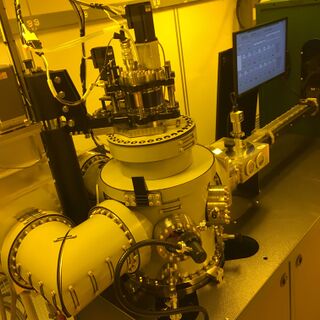ATC Orion 8: Dielectric Sputter System
|
Description
The AJA UHV Orion dielectric sputter system is capable of reaching UHV pressures as low as 1E-10 Torr. It is equipped with a load lock that allows for automatic sample transfer. There are eight magnetron guns, seven 2" guns, and one 3" gun. A total of two RF and three DC power supplies can be used on any of the eight guns, some with an internal switch box allowing for one power source to be sequentially routed to different guns, enabling automatic processes without manual cable swapping. One of the DC guns is a pulsed DC supply. Uniformity across a 6" wafer is <5% variation for the 2" guns. Pre-mixed targets of specific alloys and compounds may be sputtered. In addition, having multiple power supplies allows for co-sputtering of up to five materials simultaneously. Reactive sputtering may be performed by introducing oxygen and/or nitrogen into the chamber during process, allowing oxides and nitrides to be formed from pure metal targets. The pulsed DC supply is ideally suited for such reactive processes where a dielectric material is synthesized. Co-sputtering multiple elements in a reactive process can produce complex ceramics. An RF power supply is also present specifically for generating a localized plasma at the substrate. This can be used as a surface cleaner, etcher, for techniques such as ion-assisted deposition, and to assist in the reactive formation of metal-nitrides. This tool is also capable of substrate heating up to 800 °C, which can be used to facilitate reactions, alloying, to control film stress, and to control crystal growth mechanisms.
Reasons to Utilize Sputtering
- Ability to synthesize compounds and control compositions
- Wide variety of high quality oxides & nitrides may be synthesized
- Generally produces more uniform, better adhering films when compared to evaporation
- More conformal sidewall coverage for coating patterned substrates
- More conformal than evaporation, less conformal than CVD & ALD
Applications
- Metal and dielectric deposition
- Surface cleaning & in-situ plasma etch
- Ion-Assisted Deposition
Resources
SOPs & Troubleshooting
- KNI SOP
- Troubleshooting Guide
- Reference/supplemental Materials
- Sputter gun cable swap instructions
- QCM Deposition Rate Measurement Instructions
Tool Reservation Rules
| Advanced Reservation (days) | Limit per Reservation (hrs) | Limit per week (hrs) | |
|---|---|---|---|
| Weekday | 7 | 12 | 12 |
| Weeknight | 7 | 12 | 12 |
| Weekend | 7 | 24 | 24 |
Process Recipes
- SnO2 sputtering recipe
- NbOx sputtering recipe
- TiO2 sputtering recipe
- AlN sputtering recipe
- Al2O3 sputtering recipe
- In-situ (dielectric sputter) RF plasma etch of thermal SiO2
- Guide to maintaining a plasma using gradual pressure changes
- Material Deposition Overview - Indium-Tin Oxide
Video Tutorials
- KNI Intro to Sputtering Presentation
- Dielectric Sputter Training
- Advanced Layer Creation - Part 1
- Advanced Layer Creation - Part 2
Current Target Status
The following link will take you to a document which displays the current target configuration. This is updated after each time targets are rearranged.
Specifications
Hardware Specifications
- Typical base pressure: 1E-9 to 1E-10 Torr
- All dry pumping system (cryo & turbo & roots & diaphragm pumps)
- Load-lock-equipped system with automatic sample transfer
- Substrate holder accepts 150 mm and 100 mm wafers, as well as small chips affixed via pressure clips
- Substrate heating up to 800 °C provided by backside heating lamps
- Semiconductor grade Ar, N2, O2 process gases
- Eight Magnetron sputter guns
- Seven confocally-oriented 2" guns (faces substrate at angle)
- One centrally-located 3" gun (directly faces substrate)
- Power Supplies:
- Three RF Supplies
- One 100 W supply for substrate plasma generation
- One 600 W
- One 300 W, equipped with 3-position switch router which enables sequential switching between 3 connected magnetrons
- Two 1500 W DC
- One 2000 W pulsed DC
- Equipped with a two-position switch router that enables sequential switching between two connected magnetrons
- Frequency range: 1-100 kHz
- This unit is ideal for reactively sputtering dielectrics from metal targets
- Three RF Supplies
